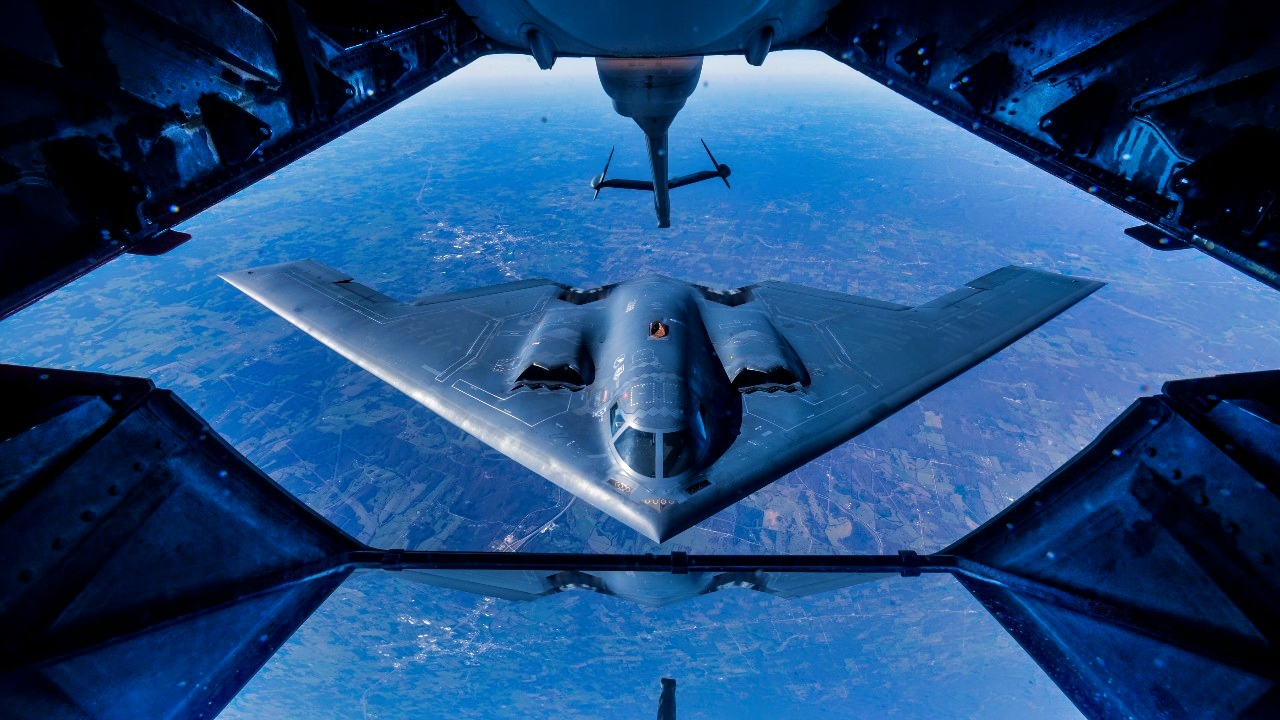Key Points and Summary – The U.S. Air Force’s B-2 Spirit stealth bomber, first flown over 30 years ago, continues to be a critical strategic asset thanks to extensive, ongoing modernization efforts.
-Recent upgrades focus on enhancing its ability to penetrate advanced air defenses and integrating new weapons.
-These include the Defensive Management System Modernization (DMS-M) for improved electronic warfare and the “Spirit Realm 1” upgrade for new flight hardware and software.
-The B-2’s arsenal has been expanded to include the long-range JASSM-ER cruise missile and the unique, 30,000-pound GBU-57 “bunker buster” bomb, ensuring its relevance until it is replaced by the B-21 Raider.
The B-2 Bomber Just Keeps Getting More Upgrades
The American B-2 stealth bomber is designed to penetrate advanced enemy air defense systems and can deliver both conventional and nuclear weapons. The aircraft is capable of flying over 6,000 nautical miles without refueling and can carry up to 40,000 pounds of ordnance in an internal weapons bay.
The stealthy design and radar-absorbing material that cover its surface provide it with the capability to evade radar detection. With its low radar cross-section, it can conduct high-risk, deep-strike, and long-range missions against very well-defended targets. The B-2 has been in service since the late 1990s, and today, almost 30 years later, it continues to play a key role in Washington’s long-range strategic operations.
The B-2 had its initial combat service during Operation Allied Force on March 24, 1999, when it was employed to strike targets in Serbia. The production of the aircraft was completed in three blocks, with all aircraft having been upgraded to the Block 30 standard, which included a new Active Electronically Scanning Array (AESA) radar.
The Air Force reduced the B-2’s total production run from an original plan of 100 to 21 aircraft due to cost and political considerations that arose from the collapse of the Soviet Union.
A single B-2 was subsequently lost in a crash at Andersen AFB on Guam on February 23, 2008, leaving only 20 aircraft left in the fleet.
A second crash in December 2022, in which the aircraft caught fire, damaged this B-2 to the point where repairs were deemed infeasible. The decision was then made to retire the B-2 instead of repairing it, which leaves the current fleet with only 19.
Modernization Projects
The modernization projects for the B-2 have two general focused objectives. One is preserving and enhancing its ability to penetrate radar networks and conduct strikes in high-end threat environments. The second is the integration of advanced weapons into the airframe.
Recent upgrades have significantly enhanced the B-2’s capability to deliver precision nuclear and conventional weapons—even under GPS-denied or degraded conditions.
The aircraft is also now capable of using radar to supply targeting data or by loading target coordinates into weapons prior to release to thwart jamming.
These upgrades have included improvements to the B-2’s ability to collect, process, and disseminate battlefield information, as well as its capacity to receive updated target information during missions.
Specific upgrades include the Defensive Management System Modernization (DMS-M) program, which has enhanced electronic warfare capabilities and data sharing, and the recent Spirit Realm 1 (SR-1) upgrade, which introduced new flight hardware, displays, and software updates. These upgrades aimed to improve the B-2’s ability to detect, locate, and categorize hostile defensive nodes, including air defense radars.
Other upgrades have been for the replacement of the primary cockpit displays, advanced IFF, and additional weapons integration. These upgrades, in aggregate, have transformed the B-2 into a platform with an easily upgradable, open-system architecture, enabling it to keep pace with emerging threats.
New Weapons
A B-2 successfully launched the longer-range JASSM-ER cruise missile in a test launch in December 2021, clearing the way for full integration of this weapon, one of the most advanced in the US arsenal. Other ongoing efforts have included Advanced Communications system upgrades to provide a Mobile User Objective System (MUOS) secure, jam-resistant SATCOM and NATO-interoperable SATURN UHF/VHF, as well as Link 16-based inflight retasking.
As the Operation Midnight Hammer mission has demonstrated, the B-2 was equipped to carry the GBU-57 Massive Ordnance Penetrator (MOP). The MOP is a heavy precision-guided bomb designed to destroy targets located deep beneath the earth.
This MOP is a 30,000-pound weapon that can penetrate through layers of soil, rock, and reinforced concrete before detonating. The B-2 can carry two of these weapons at a time, which permits it to destroy fortified structures in a single sortie.
This capability makes the B-2 unique in that it can target underground facilities that are beyond the reach of conventional bombs or cruise missiles.
The SR 1 upgrade has been a key factor in facilitating the integration of new weapons systems. One weapon that is likely to be added to the B-2’s arsenal post-upgrade is the Air Force’s new GBU-72/B bunker-buster bomb. This is a significantly smaller weapon than the GBU-57, as it is classified as a 5,000-pound weapon.
It combines the BLU-138/B bomb with a Joint Direct Attack Munition (JDAM) family GPS-assisted guidance kit.
There are also murmurs about the potential integration of hypersonic missiles onto the B-2. Specific details remain undisclosed, partly because many of these newer weapons were originally intended for the B-21. They will likely only be integrated into the B-2 if deliveries of the new-generation bomber slip to the right.
About the Author
Reuben F. Johnson is a survivor of the February 2022 Russian invasion of Ukraine and is an Expert on Foreign Military Affairs and Director of the Asian Research Centre with the Fundacja im. Kazimierza Pułaskiego in Warsaw. He has been a consultant to the Pentagon, several NATO governments and the Australian government in the fields of defense technology and weapon systems design. Over the past 30 years he has resided in and reported from Russia, Ukraine, Poland, Brazil, the People’s Republic of China and Australia.
Hypersonic Weapons In Depth
Russia’s Hypersonic Missiles Summed Up in 4 Words










